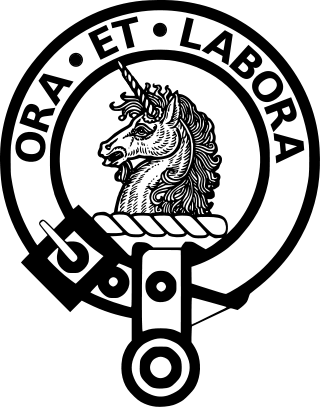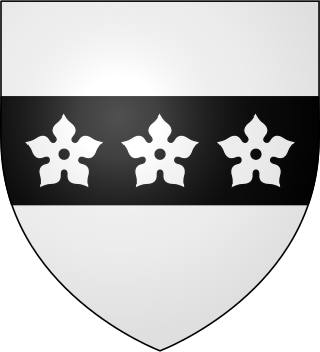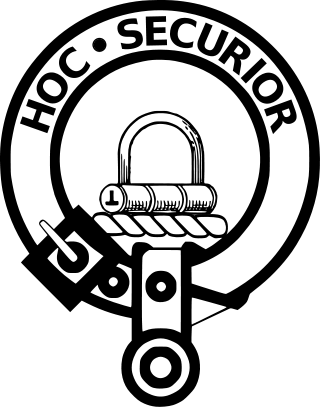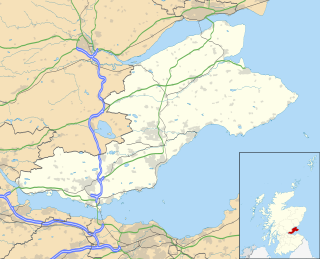
Clan Ramsay is a Lowland Scottish clan.

Clan Graham is a Scottish clan who had territories in both the Scottish Highlands and Lowlands, with one main branch Montrose, and various cadet branches. The chief of the clan rose to become the Marquess and later Duke of Montrose.

Clan Bruce is a Lowlands Scottish clan. It was a Royal House in the 14th century, producing two kings of Scotland, and a disputed High King of Ireland, Edward Bruce.

Clan Guthrie is a Scottish clan.

Clan Cochrane is a Scottish clan of the Scottish Lowlands.

Clan Seton is a Scottish clan which does not currently have a chief; therefore, it is considered an armigerous clan.

Clan Johnstone is a Border Reiver Scottish clan.

Clan Cunningham is a Scottish clan. The traditional origins of the clan are placed in the 12th century. However, the first contemporary record of the clan chiefs is in the thirteenth century. The chiefs of the Clan Cunningham supported Robert the Bruce during the Wars of Scottish Independence. In the 15th and 16th centuries, the Clan Cunningham feuded with the Clan Montgomery. Historically, the chief of Clan Cunningham held the title of Earl of Glencairn. However, in modern times the chief of the clan is Cunningham of Corsehill. On 18 December 2013, Sir John Christopher Foggo Montgomery Cunninghame, Baronet of Corsehill, was recognized by Lord Lyon as Clan Chief after the chiefship had been vacant for over 200 years.

The Forresters are an ancient and noble clan of the Scottish Lowlands.

Clan Hannay is a Lowland Scottish clan.
Clan Strachan is a Scottish clan originating from the barony of Strachan, in Aberdeenshire. The clan does not have a chief, therefore it is considered by Court of the Lord Lyon and the Stand Council of Scottish Chiefs as an Armigerous clan.

Clan Boswell is a Lowland Scottish clan and is recognized as such by the Lord Lyon King of Arms. However the clan does not currently have a chief and is therefore considered an Armigerous clan.
There have been four baronetcies created for persons with the surname Jardine, one in the Baronetage of Nova Scotia and three in the Baronetage of the United Kingdom.

Applegarthtown, also known as Applegarth or Applegirth, is a village near Lockerbie in Annandale, Dumfries and Galloway, Scotland.

Clan Grierson is a Lowlands Scottish Clan.

Clan Kirkpatrick is a Lowland armigerous Scottish clan. There are several variations of the Kirkpatrick name: Kilpatric, Kilpatrick, and Gilpatrick. The names Kirkpatrick and Kilpatrick may have been interchangeable at one time. The clan is recognised by the Court of the Lord Lyon, however the clan does not currently have a chief so recognised. The surname Kirkpatrick is also a recognized sept of Clan Douglas and Clan Colquhoun.

Clan Bissett is a Scottish clan. The clan is recognised by the Lord Lyon King of Arms but does not have a clan chief recognised by the Lord Lyon King of Arms, therefore the clan has no standing under Scots Law. Clan Bissett is considered an armigerous clan, meaning that it is considered to have had at one time a chief who possessed the chiefly arms; however, no one at present is in possession of such arms. The surname Bissett is also considered a sept of the Clan Fraser of Lovat.

The Barony of Denboig is a Scottish feudal barony Parish in the county of Fife in Scotland. In the medieval period the church and parish of Dunbog originally belonged to the Abbey of Arbroath in Angus. Arbroath or Aberbrothock Abbey was initially a Cluniac Priory founded by King William the Lion in 1178, later, around 1233, it was taken over by Tironsian monks from Kelso Abbey. Arbroath Abbey is famed as the site of the signing of the Declaration of Independence in 1320. Within the parish of Dunbog stood the Cistercian Priory of Cadvan, a cell of nearby Balmerino Abbey. Balmerino Abbey which lies on the shores of the River Tay, across from Dundee, was founded as a Cistercian house by the widow of King William the Lion in 1236. The only building of historical significance in modern Dunbog is Dunbog Mansion house which is built on the site of Cadvan Priory. At one point it was occupied by Cardinal David Beaton [born 1494- died 1546].

Clan Russell is a Scottish armigerous clan, with claimed origins in Normandy. It has ancestral ties to the English Dukes of Bedford, and has numerous descendants in Great Britain and America.

Clan Cheyne is a Scottish clan. The clan is officially recognized by the Lord Lyon King of Arms, however as the clan does not currently have a chief recognized by the Court of the Lord Lyon, it is therefore considered an Armigerous clan. The surname Cheyne is also recognized as a sept of the Clan Sutherland, and is accepted as such by the Clan Sutherland Society in Scotland.




















